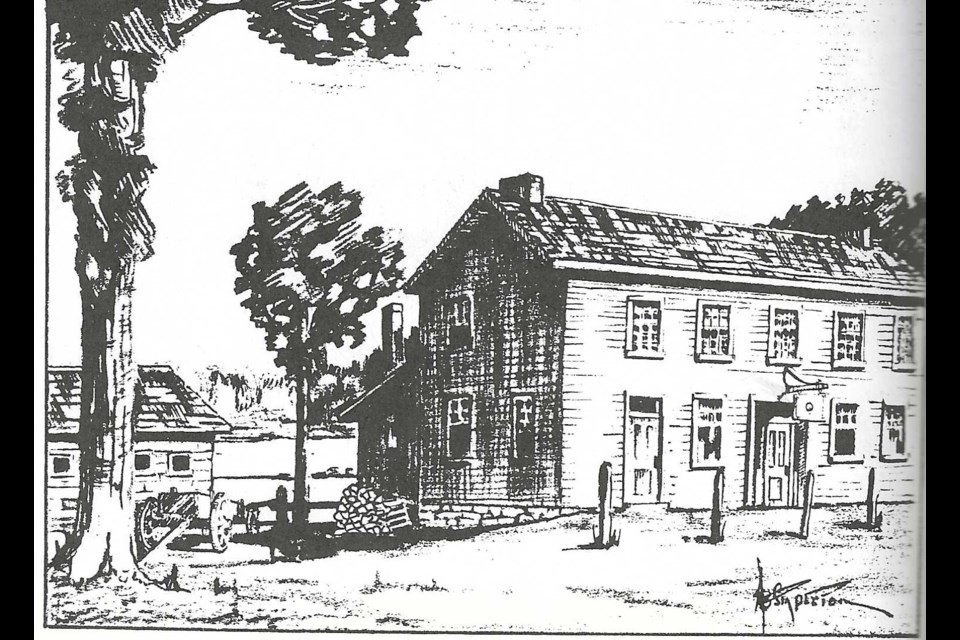Historically, communities were often established around churches, which served as central hubs for social, spiritual, and cultural life. Every early settlement included a church, and as pioneers with diverse faiths arrived, religious services were sometimes held in local inns or congregants’ homes.
In Stratford, the first church, St. Andrew’s Presbyterian, was established in 1838. By 1840, a log structure was built on the grounds where the current church now stands. Anglicans gathered at the Sargint/Shakespeare Inn, a site notable for the Sargint family's unique dynamic: while the men were devout Anglicans, their wives adhered to Roman Catholicism.
By 1840, Stratford’s population had grown to 500, and six churches had been established. Ministers and priests frequently travelled long distances, often on horseback, to deliver sermons. These journeys were not without peril—one account tells of a clergyman who nearly froze while travelling through dense bush to minister to congregations.
Denominations such as Presbyterian, Anglican, Lutheran, Methodist, United, Baptist, Congregational, Evangelical, and the Young Men’s Christian Association and Young Women’s Christian Association thrived. A notable Methodist congregation on Waterloo Street comprised black members who had escaped slavery in the United States. This congregation included local business owners and individuals supported by local farmers who provided homes and opportunities.
Ancient Christmas Traditions
While many now celebrate Christmas primarily on December 25, historical customs reflect a rich tapestry of practices tied to the twelve days of Christmas, culminating on January 6 (Epiphany).
In earlier times, the Advent season marked a four-week fast leading up to Christmas. This fasting period, including abstinence on Christmas Eve, heightened anticipation for the Christmas Day feast. Homes were adorned with greenery such as holly, ivy, and mistletoe on Christmas Eve, symbolizing eternal life. Superstition dictated that bringing greenery indoors before Christmas Eve was bad luck.
During the twelve days of Christmas, work ceased for all, including the poor, as communities celebrated the season:
- Christmas Day: Celebrations began with mass, followed by feasting to break the Advent fast.
- St. Stephen’s Day (Boxing Day): A day of charity, where the wealthy distributed food in boxes to servants and the needy.
- St. John’s Day: Marked by wassailing, where people toasted one another’s health with a spiced cider or ale mixture.
- Childermas (Feast of the Holy Innocents): A day of solemn remembrance for the children massacred by King Herod in Bethlehem.
- St. Thomas Becket Day: honouring the Archbishop of Canterbury, martyred in his cathedral.
- Mumming Plays: A mix of theatrical performances and costumed festivities.
- New Year’s Day (Julian Calendar): A time for gift-giving.
- 9-11. Merrymaking: Days dedicated to joy and celebration.
- Epiphany: Celebrating the visit of the Three Wise Men to the Christ child. This marked the end of the season, and all decorations were taken down.
The old familiar Twelve Days of Christmas carol’s gifts have a current price value of $49,263, reflecting a 5.4% increase from the previous year according to crosswalk.com.
Here's a breakdown of the costs for each gift:
- A Partridge in a Pear Tree: $370.18 ($20.18 for the partridge and $350 for the pear tree)
- Two Turtle Doves: $750
- Three French Hens: $346.50
- Four Calling Birds: $599.96
- Five Gold Rings: $1,245
- Six Geese-a-Laying: $900
- Seven Swans-a-Swimming: $13,125
- Eight Maids-a-Milking: $58 (based on federal minimum wage)
- Nine Ladies Dancing: $8,557.37
- Ten Lords-a-Leaping: $15,579.65
- Eleven Pipers Piping: $3,714.96
- Twelve Drummers Drumming: $4,016.85
These traditions highlight a time when faith and community were deeply intertwined, offering a window into the past’s rich cultural and religious practices.
May you all have a Merry Christmas and a Happy New Year.
